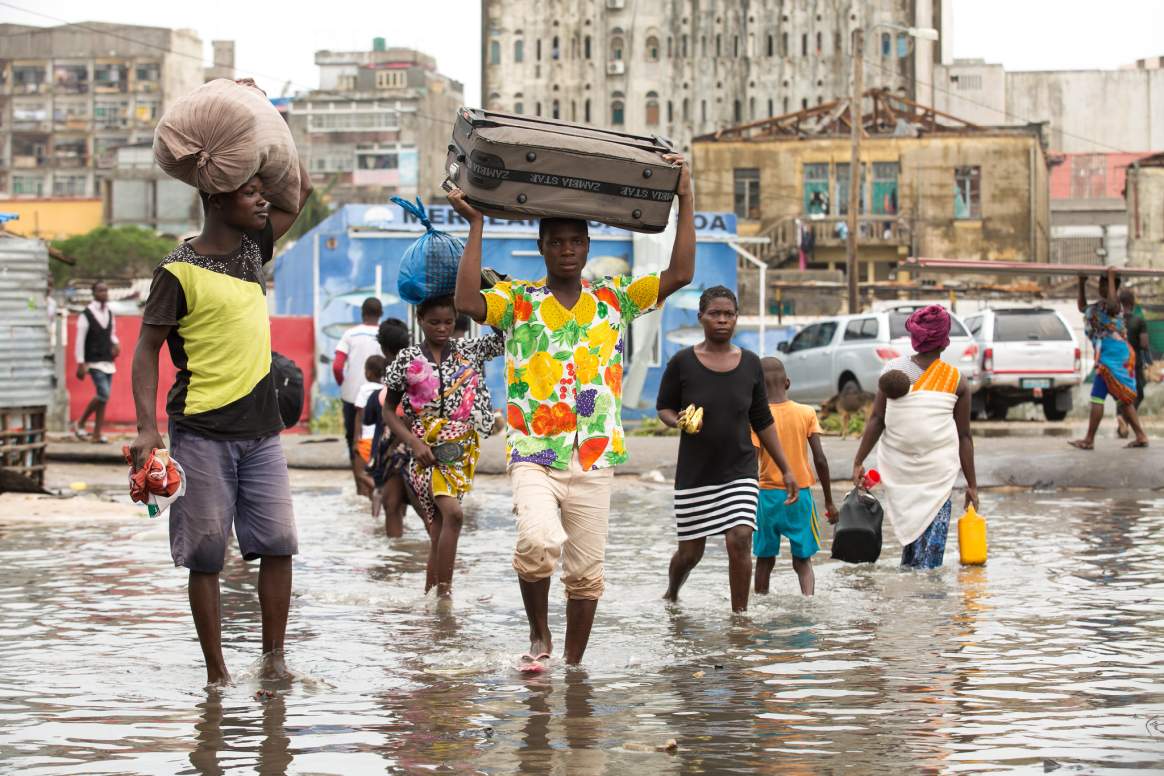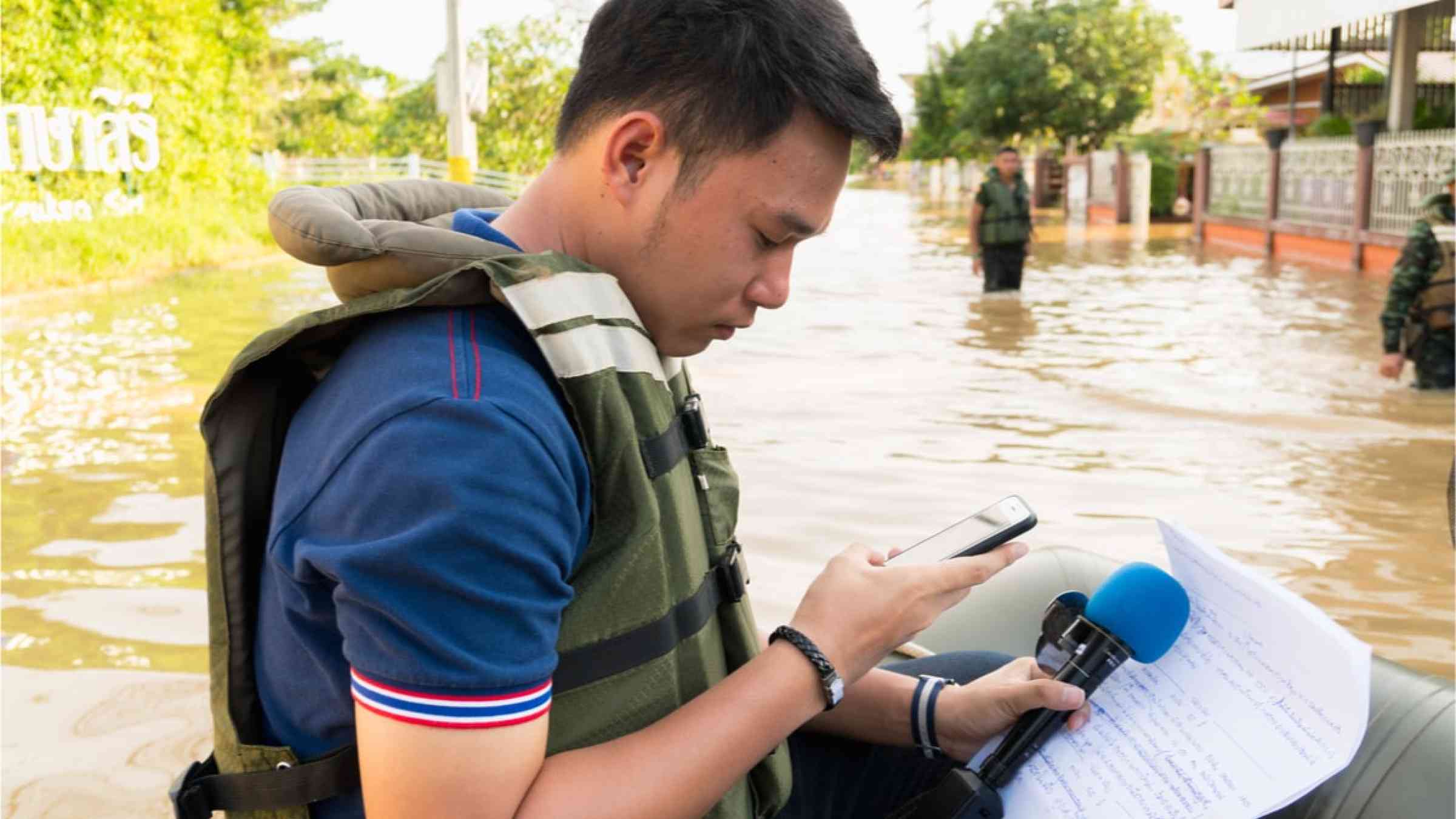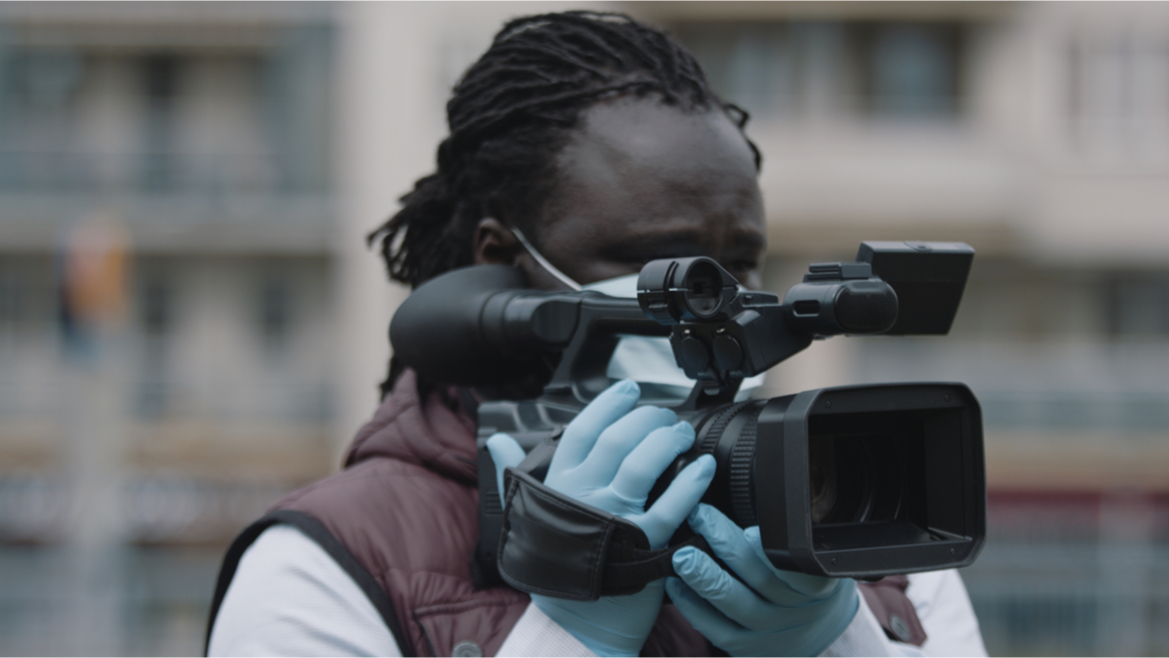Telling the other side of the disaster story
Telling the other side of the disaster story
Key questions and story angles to cover disaster risk and resilience before, during and after disasters.
In one sense, disasters represent the very definition of news – they are significant, unusual, immediate, and of great human interest. Any paper, website or news broadcast is replete with items about risks and disasters, big or small.
Apart from reporting disasters as news, however, media also have the opportunity for news analysis, investigative reporting, features, and current affairs programmes or documentaries.

Covering disasters – key questions
Most disasters can usefully be covered using the well-known “5Ws and 1H” – Who, What, When, Where, Why and How. The first four yield factual information, but the last two - Why and How - generally yield the richest answers. They will also be useful for DRR-related stories too. Other important questions might include: “What does it mean”?
General questions
- Where did it occur and when? What are the specifics of the disaster context?
- Why did it happen? What was predictable?
- What are the main underlying factors behind the tragedy (poverty, climate change, environmental degradation, urban growth, lack of governance)? Could it have been prevented?
- Was there any DRR policy in place? Was an early warning system in place? Did it function?
- How was the response?
- Did people react to it? Quote different sources.
Questions about structural elements
- How many houses were destroyed?
- How many hospitals and schools were destroyed? Was there any land-use planning in place?
- Was there any land-use planning policy integrating a multi-hazard approach?
- Were houses and schools protected against hazards?
- How were the houses built? Were any building codes in place? Was resilient building material used?
Questions about non-structural elements
- How was the environment affected? Was deforestation an issue?
- Were there any natural buffers?
- What other non-structural measures were in place?
Questions about preparedness measures
- Was there a contingency plan in place?
- How were poor people, women and children affected? What was the impact on different economic groups? Who was most impacted?
- Were there any shelters in place?
Economic questions
- What was the economic impact?
- What percentage of the economic losses were insured?
- How much should be invested in DRR?
Recovery process questions
- Can it be built back better or should there be a change of location?
- Is DRR integrated into the recovery process?
- What is needed to protect the most vulnerable populations better?
- What is the DRR budget in the reconstruction budget?
Responsibility questions
- Who was in charge at different levels?
- Who should have been in charge?
Don’t forget to debrief and learn
When your assignment is over, find time to discuss with your editor, colleagues, and senior journalists what went well and what could be improved. Examine individual performance as well as the performance of your newsroom organisation. This is your opportunity to talk about how the task could be done better the next time. Even a short review can bring serious improvements to your next round of disaster coverage.
Post-disaster stories, DRR, and resilience
Stories on DRR and resilience can be meaningful, relevant, and conducive to systemic improvements. They provide space not only to raise important issues, but also to consider various long-term and interconnected issues that can improve lives in a way that is consistent with community resilience and sustainable development.
DRR is the ideal “second-day story”
The ideal time to cover resilience and risk is of course in the days immediately after a disaster, while the impact is still being felt. DRR stories make ideal ‘second-day stories’. DRR stories are deeper, richer, more analytical or investigative. They examine causes, issues and implications of the disaster. With a bit of thought, they are easy to find. See, for example, the wealth of DRR- and resilience-related coverage that emerged from COVID-19. There is no shortage of fresh story ideas when journalists put their minds to it.
Disaster risk reduction? Don’t hold the front page
From UN staff to aid workers and journalists, many people struggle to make disaster risk reduction (DRR) sound more interesting.
Even the term ‘disaster risk reduction’ can be off putting. But most people out there in the real world still need to know more about this issue.
Want to pitch a story idea about protecting people from disasters?
Post-disaster questions you can ask
There is a huge range of questions you can ask and approaches you can take. Some of them are listed below.
- Question the lack of early warning
- Question the lack of urban planning
- Question the lack of building resilience
- Question the lack of education and preparedness
- Question the lack of a clear national strategy for disaster risk reduction aligned with the priorities for action in the Sendai Framework
- Question the resources available to the national disaster management agency
- Question the level of greenhouse gas emissions and efforts to decarbonize the economy
- Question if sufficient measures are being taken to adapt to climate change/ climate emergency
- Question if the private sector is taking a risk-informed approach to new investments
- Question the performance of people responsible for disaster management
- Question the lack of investment, financial resources and political will in DRR
- Question DRR measures in place: how well did they work?
- Question the recovery and reconstruction phases and publish editorials that can trigger a debate
- Think about social vulnerability and the gender issue: why do more women than men die in disasters?
- Investigate the economic, social, cultural impacts of the disaster.
- Examine other long-term effects
- Draw out the lessons to be learned, using expert opinion
- Analyse in depth the causes of the disaster: Why did it happen? Could it have been averted?
- Recall the economic and human cost of past recoveries, the absence of lessons learned
- Look at similar threats or previous disasters in other countries to inform about possible solutions
- Develop stories where similar disasters may happen or are bound to happen given similar vulnerabilities and hazard trends.
- Keep post-disaster issues in the news (necessary investments, measures that need to be taken, corruption, lack of political priorities). Can it happen again? What needs to be improved?
- Continue informing and investigating to change attitudes and policies.
- Be alert for new disaster hazards; visit exposed sites.
- Keep the topic alive by including DRR issues in cultural and social events covered by media (e.g. children’s programmes, current affairs programmes, talk shows, soap operas, etc.).
Long-term DRR stories
You can continue your DRR coverage even when the immediate disaster is done. During a disaster and its immediate aftermath, you will be run off your feet trying to keep up with developments and the news cycle. But it can also be a valuable opportunity to build contacts with experts in disaster management and related fields. Cultivate those sources even when the intense phase of coverage is over and they will yield a rich crop of stories. Following resilience issues all year round will not only develop your contacts and skills, it will also establish your credibility with experts and audiences alike.
What can extreme event attribution tell us?
An extreme event attribution study can tell us whether global warming made (or will make) an event more likely than it would have been without the rise in greenhouse gases. It can tell us whether the time between similar events is shorter or longer than it used to be. It can therefore tell us what the risk is for a given extreme weather event and whether (or how much) global warming has increased that risk.
Finding the right news peg
Many DRR stories will pass the test of newsworthiness even when there is no disaster in sight. The key will be to “hang” your story on a “news peg”.
Disaster anniversaries provide an ideal platform for raising DRR issues. But DRR stories do not come to you, you must go after them. These anniversaries are ideal occasions to make a start and convince your editor that you have a story to tell.
Some risks and hazards are not marked by single disasters or events. This is the case for global warming and climate change. In such cases, the release of reports and findings, international conferences and events, and connected events such as severe storms in other parts of the world can provide a convenient news peg for stories in your area. Media outlets sometimes launch campaigns around such issues, as the British newspaper The Guardian did for climate change which they now refer to as the Climate Emergency.
- Investigate the potential threats and risks that might endanger the lives of populations in your village or country (informal settlements, poor construction in disaster-prone zones and destruction of natural environmental buffers).
- Investigate the degree of DRR measures undertaken (prevention, mitigation, preparedness, recovery) and how they reduce risk.
- Do not wait for a disaster to happen before writing about potential threats. Be proactive.
- Focus on how communities prepare for disasters e.g. before the rainy season.
- Cover drills, preparedness exercises, education measures and activities to inform people of their risk and vulnerabilities and educate them about what they can do.
- Conduct interviews with experts and disaster management authorities and initiate a possible debate on a DRR issue.
- Develop regular stories on people’s vulnerabilities to disasters, their social, environmental and economic vulnerabilities.
- Report on how the public and governments interact.
- Link any story on the environment, poverty, climate change or urban risk to a disaster risk reduction issue; in other words, report on disasters in the making where vulnerabilities are developing in hazard-prone zones.
- Take any international disaster opportunity to highlight a local or national potential threat.
- Keep the memory of past disasters alive: people tend to forget and react only when disasters happen.
- Commemorate the International Day for Disaster Reduction, which is on 13 October and World Tsunami Awareness Day on November 5.
Solutions Journalism
Though coverage of climate change and global warming is increasing, solutions are mentioned rarely. The Solutions Journalism Network describes solution journalism as rigorous, evidence-based reporting on responses to social problems, which provides insights that can help others. It suggests that journalists don’t just have to be “watchdogs” exposing wrongdoing and demanding accountability. They can also be “guide dogs” who focus on positive action.
Solutions stories offer fresh angles for journalists. Audiences say they prefer this shift away from ‘negativity’ and of course such stories disseminate valuable information on responses, encouraging wider adoption and further innovation.
The Solutions Journalism Network suggests asking these key questions for solutions stories:
- Who’s doing it better?
- How does the response work?
- What parts of the problem aren’t addressed by the response?
- Where did this idea come from?
- Is it being replicated elsewhere? With what effect?
- What does the research say?
- What do the critics say?
- What metrics matter when it comes to measuring success?
- In what ways is that response working, in what ways is it not working, and how do we know?
- What are the barriers to replication?

It also suggests ways in which to avoid slipping away from impartial reporting and into advocacy for particular solutions:
- Don’t overclaim
- Show what the character does, not what s/he aims to do
- Let readers draw their own conclusions
- Reveal characters’ challenges
- Do not shy away from dark moments
- Look for unlikely characters
- Take out the words “inspiring,” “solution,” “wonderful,” “super,” “unique,” “genius”

